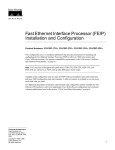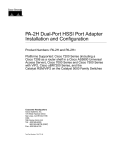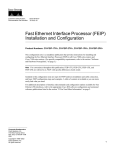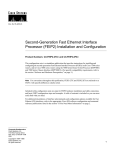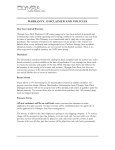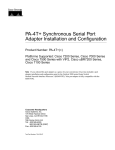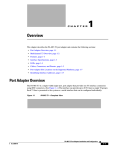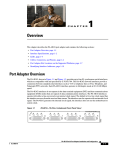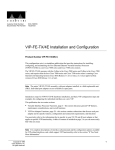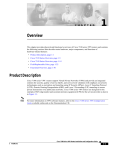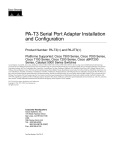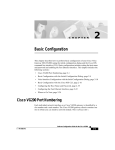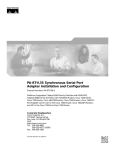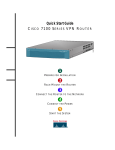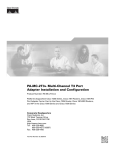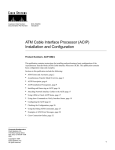Download Cisco PA-FE-TX (PAFETX) Expansion Module
Transcript
C H A P T E R 4 Configuring the PA-FE-TX or PA-FE-FX To continue your PA-FE-TX or PA-FE-FX port adapter installation, you must configure the Fast Ethernet interface. The instructions that follow apply to all supported platforms. Minor differences between the platforms—with Cisco IOS software commands—are noted. This chapter contains the following sections: • Using the EXEC Command Interpreter, page 4-1 • Configuring the Interfaces, page 4-2 • Checking the Configuration, page 4-5 Using the EXEC Command Interpreter You modify the configuration of your router through the software command interpreter called the EXEC (also called enable mode). You must enter the privileged level of the EXEC command interpreter with the enable command before you can use the configure command to configure a new interface or change the existing configuration of an interface. The system prompts you for a password if one has been set. The system prompt for the privileged level ends with a pound sign (#) instead of an angle bracket (>). At the console terminal, use the following procedure to enter the privileged level: Step 1 At the user-level EXEC prompt, enter the enable command. The EXEC prompts you for a privileged-level password as follows: Router> enable Password: Step 2 Enter the password (the password is case sensitive). For security purposes, the password is not displayed. When you enter the correct password, the system displays the privileged-level system prompt (#): Router# To configure the new interfaces, proceed to the “Configuring the Interfaces” section on page 4-2. Cisco PA-FE-TX and Cisco PA-FE-FX Fast Ethernet 100BaseT Port Adapter Installation and Configuration OL-2899-03 4-1 Chapter 4 Configuring the PA-FE-TX or PA-FE-FX Configuring the Interfaces Configuring the Interfaces After you verify that the new PA-FE-TX or PA-FE-FX is installed correctly (the enabled LED goes on), use the privileged-level configure command to configure the new interfaces. Have the following information available: • Protocols you plan to route on each new interface • IP addresses, if you plan to configure the interfaces for IP routing • Bridging protocols you plan to use If you installed a new PA-FE-TX or PA-F-FX or if you want to change the configuration of an existing interface, you must enter configuration mode to configure the new interfaces. If you replaced a PA-FE-TX or PA-FE-FX that was previously configured, the system recognizes the new interfaces and brings each of them up in their existing configuration. For a summary of the configuration options available and instructions for configuring interfaces on a PA-FE-TX or PA-FE-FX, refer to the appropriate configuration publications listed in the “Related Documentation” section on page viii. You execute configuration commands from the privileged level of the EXEC command interpreter, which usually requires password access. Contact your system administrator, if necessary, to obtain password access. (See the “Using the EXEC Command Interpreter” section on page 4-1 for an explanation of the privileged level of the EXEC.) This section contains the following subsections: • Performing a Basic Configuration, page 4-2 • Configuring PA-FE-TX or PA-FE-FX Transmission Mode, page 4-4 • Configuring PA-FE-TX or PA-FE-FX Media Type, page 4-4 Performing a Basic Configuration Following are instructions for a basic configuration: enabling an interface and specifying IP routing. You might also need to enter other configuration subcommands, depending on the requirements for your system configuration and the protocols you plan to route on the interface. For complete descriptions of configuration subcommands and the configuration options available for interfaces, refer to the appropriate software documentation. In the following procedure, press the Return key after each step unless otherwise noted. At any time you can exit the privileged level and return to the user level by entering disable at the prompt as follows: Router# disable Router> Step 1 At the privileged-level prompt, enter configuration mode and specify that the console terminal is the source of the configuration subcommands, as follows: Router# configure terminal Enter configuration commands, one per line. End with CNTL/Z. Router(config)# Cisco PA-FE-TX and Cisco PA-FE-FX Fast Ethernet 100BaseT Port Adapter Installation and Configuration 4-2 OL-2899-03 Chapter 4 Configuring the PA-FE-TX or PA-FE-FX Configuring the Interfaces Step 2 The following examples explain how to configure the Fast Ethernet interface: • For the Cisco 7100 series, Cisco 7200 series, and the Cisco uBR7200 series, at the prompt specify the first interface to configure by entering the subcommand interface, followed by the type (fastethernet) and slot/interface (port adapter slot number and interface number). The example that follows is for the first interface of the port adapter in slot 4: Router(config)# interface fastethernet 4/0 Note • For the Cisco 7206VXR and Cisco 7206 router shelves in the Cisco AS5800 Universal Access Server, the interface specified in the above example would include a shelf number. For example, the command interface fastethernet 5/4/0 would specify the first Fast Ethernet interface of the port adapter in slot 4 of router shelf 5. For the Cisco 7301 router, the Cisco 7401ASR router, and the Cisco 7304 PCI Port Adapter Carrier Card in a Cisco 7304 router, at the prompt specify the first interface to configure by entering the subcommand interface, followed by the type (fastethernet) and slot/interface (port adapter slot number and interface number). The example that follows is for the first interface of the port adapter in slot 1: Router(config)# interface fastethernet 1/0 • For the VIP, at the prompt specify the first interface to configure by entering the subcommand interface, followed by the type (fastethernet) and slot/port-adapter/interface. The example that follows is for the first interface of the first port adapter, on a VIP in interface processor slot 1: Router(config)# interface fastethernet 1/0/0 • For the Catalyst RSM/VIP2, at the prompt specify the first interface to configure by entering the subcommand interface, followed by the type (fastethernet) and port-adapter/interface. The example that follows is for the first interface of the first port adapter, on a Catalyst RSM/VIP2: Router(config)# interface fastethernet 0/0 Step 3 If IP routing is enabled on the system, you can assign an IP address and subnet mask to the interface with the ip address configuration subcommand, as in the following example: Router(config-if)# ip address 10.0.0.0 10.255.255.255 Step 4 Add any additional configuration subcommands required to enable routing protocols and set the interface characteristics. Step 5 Change the shutdown state to up and enable the interface as follows: Router(config-if)# no shutdown Step 6 Configure additional interfaces as required. Step 7 After including all of the configuration commands to complete your configuration, press Ctrl-Z—hold down the Control key while you press Z—or enter end or exit to exit configuration mode and return to the EXEC command interpreter prompt. Step 8 Write the new configuration to NVRAM as follows: Router# copy running-config startup-config [OK] Router# This completes the procedure for creating a basic configuration. Cisco PA-FE-TX and Cisco PA-FE-FX Fast Ethernet 100BaseT Port Adapter Installation and Configuration OL-2899-03 4-3 Chapter 4 Configuring the PA-FE-TX or PA-FE-FX Configuring the Interfaces Configuring PA-FE-TX or PA-FE-FX Transmission Mode Half-duplex operation is the default transmission mode for the PA-FE-TX or PA-FE-FX. Use the full-duplex command to configure full-duplex operation for the PA-FE-TX or PA-FE-FX as follows: Router# configure terminal Enter configuration commands, one per line. End with CNTL/Z. Router(config)# Router(config)# interface fastethernet 4/0 Router(config-if)# full-duplex Ctrl-z Use the show interfaces fastethernet command to verify that the 4/0 Fast Ethernet interface is now configured for full-duplex operation as follows: Router# show interfaces fastethernet 4/0 FastEthernet 4/0 is administratively up, line protocol is up (display text omitted) Encapsulation ARPA, loopback not set, keepalive not set, fdx, 100BaseTX Use the no full-duplex command to return the interface to half-duplex operation as follows: Router# configure terminal Enter configuration commands, one per line. End with CNTL/Z. Router(config)# interface fastethernet 4/0 Router(config-if)# no full-duplex Ctrl-z Router# Use the show interfaces fastethernet command to verify that the 4/0 Fast Ethernet interface is now configured for half-duplex operation as follows: Router# show interfaces fastethernet 4/0 FastEthernet2/0 is administratively up, line protocol is up (display text omitted) Encapsulation ARPA, loopback not set, keepalive not set, hdx, 100BaseTX (display text omitted) To check the interface configuration using show commands, proceed to the “Checking the Configuration” section on page 4-5 Note When you enter the show interfaces fastethernet command using Cisco IOS Release 11.1(10) or later, or Release 11.2(4) or later with updated Cisco hardware, the “overrun” field is always zero. If you use this command because you are troubleshooting potential network problems, you may be expecting to see a number in the overrun field. Configuring PA-FE-TX or PA-FE-FX Media Type The RJ-45 receptacle is the default media type for the PA-FE-TX and the SC receptacle (for fiber-optic connections) is the default media type for the PA-FE-FX. Use the media-type mii command to configure the MII receptacle as the media type for the PA-FE as follows: Router# configure terminal Enter configuration commands, one per line. End with CNTL/Z. Router(config)# interface fastethernet 4/0 Router(config-if)# media-type mii Ctrl-z Cisco PA-FE-TX and Cisco PA-FE-FX Fast Ethernet 100BaseT Port Adapter Installation and Configuration 4-4 OL-2899-03 Chapter 4 Configuring the PA-FE-TX or PA-FE-FX Checking the Configuration Router# show interface fastethernet 4/0 FastEthernet3/0/0 is administratively up, line protocol is up (display text omitted) Encapsulation ARPA, loopback not set, keepalive not set, hdx, MII (display text omitted) Use the media-type 100 command to return the media type for the PA-FE-TX or PA-FE-FX to the RJ-45 receptacle or SC receptacle. To check the interface configuration using show commands, proceed to the “Checking the Configuration” section on page 4-5. Checking the Configuration After configuring the new interface, use the show commands to display the status of the new interface or all interfaces, and use the ping command to check connectivity. This section includes the following subsections: • Using show Commands to Verify the Interface Status, page 4-5 • Using the ping Command to Verify Network Connectivity, page 4-22 Using show Commands to Verify the Interface Status This section demonstrates how you can use the show commands to verify that interfaces are configured and operating correctly and that the port adapter appears in them correctly. Sample displays of the output of selected show commands appear in the sections that follow. For complete command descriptions and examples, refer to the publications listed in the “Related Documentation” section on page viii. If an interface is shut down and you configured it as up, or if the displays indicate that the hardware is not functioning properly, ensure that the interface is properly connected and terminated. If you still have problems bringing up the interface, contact a service representative for assistance. This section includes the following subsections: • Using the show controllers Commands, page 4-6 • Using the show protocols Command, page 4-6 • Using the show running-config Command, page 4-6 • Using the show startup-config Command, page 4-7 • Using the show version or show hardware Commands, page 4-8 • Using the show diag Command, page 4-13 • Using the show interfaces Command, page 4-17 Choose the subsection appropriate for your system. Proceed to the “Using the ping Command to Verify Network Connectivity” section on page 4-22 when you have finished using the show commands. Cisco PA-FE-TX and Cisco PA-FE-FX Fast Ethernet 100BaseT Port Adapter Installation and Configuration OL-2899-03 4-5 Chapter 4 Configuring the PA-FE-TX or PA-FE-FX Checking the Configuration Using the show controllers Commands Display all the current interface processors and their interfaces using the show controllers command. Note The outputs that appear in this document may not match the output you receive when running these commands. The outputs in this document are examples only. The following is an example of the show controllers command: Router# show controllers MEMD at 40000000, 2097152 bytes (unused 3360, recarves 1, lost 0) RawQ 48000100, ReturnQ 48000108, EventQ 48000110 BufhdrQ 48000128 (2900 items), LovltrQ 48000140 (5 items, 2016 bytes) IpcbufQ 48000150 (16 items, 4096 bytes) IpcbufQ_classic 48000148 (8 items, 4096 bytes) 3570 buffer headers (48002000 - 4800FF10) pool0: 9 buffers, 256 bytes, queue 48000130 pool1: 344 buffers, 1536 bytes, queue 48000138 pool2: 284 buffers, 4544 bytes, queue 48000158 pool3: 4 buffers, 4576 bytes, queue 48000160 slot2: VIP2, hw 2.4, sw 22.20, ccb 5800FF40, cmdq 48000090 software loaded from flash slot0:vip2_22-20.atmdx.191897 IOS (tm) VIP Software (SVIP-DW-M), Experimental Version 11.3 ROM Monitor version 17.0 ATM2/0/0, applique is DS3 (45Mbps) gfreeq 48000158, lfreeq 48000168 (4544 bytes), throttled 0 rxlo 4, rxhi 284, rxcurr 1, maxrxcurr 5 txq 48001A00, txacc 48001A02 (value 284), txlimit 284 Using the show protocols Command Display protocols configured for the entire system and for specific interfaces using the show protocols command. Note The outputs that appear in this document may not match the output you receive when running these commands. The outputs in this document are examples only. The following is an example of the show protocols command: Router# show protocols line protocol is up Router# Using the show running-config Command Display the running configuration file using the show running-config command. Note The outputs that appear in this document may not match the output you receive when running these commands. The outputs in this document are examples only. Cisco PA-FE-TX and Cisco PA-FE-FX Fast Ethernet 100BaseT Port Adapter Installation and Configuration 4-6 OL-2899-03 Chapter 4 Configuring the PA-FE-TX or PA-FE-FX Checking the Configuration The following is an example of the show running-config command: Router# show running-config Building configuration... Current configuration: ! ! ! user add admin uid 0 capability admin-access ! ! ! hostname CR4430 ! interface ethernet 0 ip address 10.2.2.8 255.255.255.0 ip broadcast-address 10.2.2.255 exit ! interface ethernet 1 exit ! ip default-gateway 10.2.2.1 ip name-server 10.2.2.6 ip route 0.0.0.0 0.0.0.0 10.2.2.1 Using the show startup-config Command Display the configuration stored in the NVRAM using the show startup-config command. Note The outputs that appear in this document may not match the output you receive when running these commands. The outputs in this document are examples only. The following is an example of the show startup-config command: Router# show startup-config Building configuration... Current configuration: ! version 12.0 service timestamps debug uptime service timestamps log uptime no service password-encryption ! hostname rp-3640-2b ! ip subnet-zero ! ip audit notify log ip audit po max-events 100 ! crypto isakmp policy 1 hash md5 authentication pre-share crypto isakmp key cisco123 address 95.95.95.2 ! crypto ipsec transform-set rtpset esp-des esp-md5-hmac ! crypto map rtp 1 ipsec-isakmp Cisco PA-FE-TX and Cisco PA-FE-FX Fast Ethernet 100BaseT Port Adapter Installation and Configuration OL-2899-03 4-7 Chapter 4 Configuring the PA-FE-TX or PA-FE-FX Checking the Configuration set peer 95.95.95.2 set transform-set rtpset match address 115 ! interface Ethernet0/0 ip address 98.98.98.1 255.255.255.0 no ip directed-broadcast ! interface Ethernet0/1 ip address 99.99.99.2 255.255.255.0 no ip directed-broadcast no ip route-cache no ip mroute-cache crypto map rtp ! interface Ethernet0/2 no ip address no ip directed-broadcast shutdown ! interface Ethernet0/3 no ip address no ip directed-broadcast shutdown ! ip classless ip route 0.0.0.0 0.0.0.0 99.99.99.1 no ip http server ! access-list 115 permit ip 98.98.98.0 0.0.0.255 10.103.1.0 0.0.0.255 access-list 115 deny ip 98.98.98.0 0.0.0.255 any ! line con 0 transport input none line aux 0 line vty 0 4 login ! end Using the show version or show hardware Commands Display the configuration of the system hardware, the number of each interface type installed, the Cisco IOS software version, the names and sources of configuration files, and the boot images, using the show version (or show hardware) command. Note The outputs that appear in this document may not match the output you receive when running these commands. The outputs in this document are examples only. Cisco PA-FE-TX and Cisco PA-FE-FX Fast Ethernet 100BaseT Port Adapter Installation and Configuration 4-8 OL-2899-03 Chapter 4 Configuring the PA-FE-TX or PA-FE-FX Checking the Configuration The following sections offer some platform-specific output examples using the show version command: • Catalyst 5000 Family Switches with RSM/VIP2—Example Output of the show version Command, page 4-9 • Cisco 7000 Series Routers—Example Output of the show version Command, page 4-9 • Cisco 7100 Series Routers—Example Output of the show version Command, page 4-10 • Cisco 7200 Series Routers, Cisco 7200 VXR Routers, and Cisco uBR7200 Series Routers—Example Output of the show version Command, page 4-10 • Cisco 7301 Routers—Example Output of the show version Command, page 4-11 • Cisco 7401ASR Routers—Example Output of the show version Command, page 4-11 • Cisco 7500 Series Routers with VIP—Example Output of the show version Command, page 4-12 Catalyst 5000 Family Switches with RSM/VIP2—Example Output of the show version Command Following is an example of the show version command from a Catalyst 5000 family switch: Router# show version Cisco Internetwork Operating System Software IOS (tm) GS Software (RSP-A), Version 11.1(6)CA Copyright (c) 1986-1995 by cisco Systems, Inc. Compiled Fri 06-Oct-95 12:22 by mpo Image text-base: 0x600088A0, data-base: 0x605A4000 ROM: System Bootstrap, Version 5.3(16645) RELEASED SOFTWARE ROM: GS Bootstrap Software (RSP-BOOT-M), Version 11.1(6)CA, RELEASED SOFTWARE honda uptime is 4 hours, 22 minutes System restarted by reload System image file is “slot0:rsp-a111-1”, booted via slot0 cisco RSP2 (R4600) processor with 32768K bytes of memory. R4600 processor, Implementation 32, Revision 2.0 Last reset from power-on G.703/E1 software, Version 1.0. Bridging software. X.25 software, Version 2.0, NET2, BFE and GOSIP compliant. Chassis Interface. 1 VIP2 controllers (1 FastEthernet). 1 FastEthernet/IEEE 802.3 interfaces. 125K bytes of non-volatile configuration memory. 20480K bytes of Flash PCMCIA card at slot 0 (Sector size 128K). 8192K bytes of Flash internal SIMM (Sector size 256K). No slave installed in slot 6. Configuration register is 0x2 Cisco 7000 Series Routers—Example Output of the show version Command Following is an example of the show version command from a Cisco 7000 series router: Router# show version Cisco Internetwork Operating System Software IOS (tm) C2600 Software (C2600-IS-M), Version 12.0(7)T, RELEASE SOFTWARE (fc2) Copyright (c) 1986-1999 by cisco Systems, Inc. Compiled Tue 07-Dec-99 02:21 by phanguye Image text-base: 0x80008088, data-base: 0x80C524F8 ROM: System Bootstrap, Version 11.3(2)XA4, RELEASE SOFTWARE (fc1) Cisco PA-FE-TX and Cisco PA-FE-FX Fast Ethernet 100BaseT Port Adapter Installation and Configuration OL-2899-03 4-9 Chapter 4 Configuring the PA-FE-TX or PA-FE-FX Checking the Configuration Router uptime is 3 minutes System returned to ROM by abort at PC 0x802D0B60 System image file is "flash:c2600-is-mz.120-7.T" cisco 2611 (MPC860) processor (revision 0x202) with 26624K/6144K bytes of memory. Processor board ID JAB031202NK (3878188963) M860 processor: part number 0, mask 49 Bridging software. X.25 software, Version 3.0.0. Basic Rate ISDN software, Version 1.1. 2 Ethernet/IEEE 802.3 interface(s) 2 Serial(sync/async) network interface(s) 1 ISDN Basic Rate interface(s) 32K bytes of non-volatile configuration memory. 8192K bytes of processor board System flash partition 1 (Read/Write) 8192K bytes of processor board System flash partition 2 (Read/Write) Cisco 7100 Series Routers—Example Output of the show version Command Following is an example of the show version command from a Cisco 7120 series router: Router# show version Cisco Internetwork Operating System Software IOS (tm) EGR Software (c7100-IS-M), Version 12.0(4)XE, EARLY DEPLOYMENT RELEASE) TAC:Home:SW:IOS:Specials for info Copyright (c) 1986-1999 by cisco Systems, Inc. Compiled Thu 10-Jun-99 15:32 by linda Image text-base:0x60008900, data-base:0x60D8E000 ROM:System Bootstrap, Version 12.0(19990720:023243) [gautham-conn_4xe-PRE_ALPHE BOOTFLASH:EGR Software (c7100-IS-M), Version 12.0(4)XE, EARLY DEPLOYMENT RELEA) Router uptime is 24 minutes System restarted by power-on System image file is "disk0:c7100-is-mz.120-4.XE" cisco 7120-bad (EGR) processor with 61440K/69632K bytes of memory. R527x CPU at 225Mhz, Implementation 40, Rev 10.0, 2048KB L2 Cache Last reset from power-on Bridging software. X.25 software, Version 3.0.0. 2 FastEthernet/IEEE 802.3 interface(s) 125K bytes of non-volatile configuration memory. 40960K bytes of ATA PCMCIA card at slot 0 (Sector size 512 bytes). 8192K bytes of Flash internal SIMM (Sector size 256K). Configuration register is 0x2000 Cisco 7200 Series Routers, Cisco 7200 VXR Routers, and Cisco uBR7200 Series Routers—Example Output of the show version Command Following is an example of the show version command from a Cisco 7200 series router: Router# show version Cisco Internetwork Operating System Software IOS (tm) 7200 Software (C7200-J-M), Version 11.1(7)CA [biff 105] Copyright (c) 1986-1996 by cisco Systems, Inc. Compiled Sun 04-Aug-96 06:00 by biff Image text-base: 0x600088A0, data-base: 0x605A4000 Cisco PA-FE-TX and Cisco PA-FE-FX Fast Ethernet 100BaseT Port Adapter Installation and Configuration 4-10 OL-2899-03 Chapter 4 Configuring the PA-FE-TX or PA-FE-FX Checking the Configuration ROM: System Bootstrap, Version 11.1(7)CA RELEASED SOFTWARE Router uptime is 4 hours, 22 minutes System restarted by reload System image file is “c7200-j-mz”, booted via slot0 cisco 7206 (NPE150) processor with 12288K/4096K bytes of memory. R4700 processor, Implementation 33, Revision 1.0 (Level 2 Cache) Last reset from power-on Bridging software. SuperLAT software (copyright 1990 by Meridian Technology Corp). X.25 software, Version 2.0, NET2, BFE and GOSIP compliant. TN3270 Emulation software (copyright 1994 by TGV INC). Chassis Interface. 4 Ethernet/IEEE 802.3 interfaces. 2 FastEthernet/IEEE 802.3 interfaces. 4 Token Ring /IEEE802.5 interfaces. 12 Serial network interfaces. 1 Compression module. 125K bytes of non-volatile configuration memory. 1024K bytes of packet SRAM memory. Cisco 7301 Routers—Example Output of the show version Command Following is an example of the show version command from a Cisco 7301 router: Router# show version Cisco Internetwork Operating System Software IOS (tm) 7301 Software (C7300-JS-M), Experimental Version 12.2(20020904:004736) [biff 107] Copyright (c) 1986-2002 by cisco Systems, Inc. Compiled Mon 09-Sep-02 18:02 by biff Image text-base:0x600088F8, data-base:0x61A94000 ROM:System Bootstrap, Version 12.2(20020730:200705) [biff-TAZ2_QA_RELEASE_16B 101], DEVELOPMENT SOFTWARE BOOTLDR:7301 Software (C7301-BOOT-M), Experimental Version 12.2(20020813:014224) [biff-TAZ2_QA_RELEASE_17B 101] 7301p2b uptime is 0 minutes System returned to ROM by reload at 00:01:51 UTC Sat Jan 1 2000 System image file is "tftp://10.1.8.11/tazii/images/c7301-js-mz" cisco 7301 (NPE-G1) processor (revision A) with 491520K/32768K bytes of memory. Processor board ID 0 BCM1250 CPU at 700Mhz, Implementation 1, Rev 0.2, 512KB L2 Cache 1 slot midplane, Version 2.0 Last reset from power-on Bridging software. X.25 software, Version 3.0.0. SuperLAT software (copyright 1990 by Meridian Technology Corp). TN3270 Emulation software. 3 Gigabit Ethernet/IEEE 802.3 interface(s) 509K bytes of non-volatile configuration memory. 62976K bytes of ATA PCMCIA card at slot 0 (Sector size 512 bytes). 32768K bytes of Flash internal SIMM (Sector size 256K). Configuration register is 0x102 Cisco 7401ASR Routers—Example Output of the show version Command Following is an example of the show version command from a Cisco 7401ASR router: Cisco PA-FE-TX and Cisco PA-FE-FX Fast Ethernet 100BaseT Port Adapter Installation and Configuration OL-2899-03 4-11 Chapter 4 Configuring the PA-FE-TX or PA-FE-FX Checking the Configuration Router# show version Cisco Internetwork Operating System Software IOS (tm) 7401ASR Software (C7401ASR-J-M), Version 11.1(6)CA Copyright (c) 1986-1996 by cisco Systems, Inc. Compiled Sun 21-Apr-95 12:22 by Image text-base: 0x600088A0, data-base: 0x605A4000 ROM: System Bootstrap, Version 11.1(6)CA Router uptime is 4 hours, 22 minutes System restarted by reload System image file is “slot0:c7401ASR-j-mz.960421”, booted via slot0 cisco 7401ASR (R4700) processor with 22528K/10240K bytes of memory. R4700 processor, Implementation 33, Revision 1.0 (Level 2 Cache) Last reset from power-on Bridging software. X.25 software, Version 2.0, NET2, BFE and GOSIP compliant. Chassis Interface. 4 Ethernet/IEEE 802.3 interfaces. 2 FastEthernet/IEEE 802.3 interfaces. 125K bytes of non-volatile configuration memory. 20480K bytes of Flash PCMCIA card at slot 0 (Sector size 128K). 8192K bytes of Flash internal SIMM (Sector size 256K). Configuration register is 0x2 Cisco 7500 Series Routers with VIP—Example Output of the show version Command Following is an example of the show version command from a Cisco 7500 series router with a VIP2: Router# show version Cisco Internetwork Operating System Software IOS (tm) GS Software (RSP-A), Version 11.1(6)CA Copyright (c) 1986-1995 by cisco Systems, Inc. Compiled Fri 06-Oct-95 12:22 by mpo Image text-base: 0x600088A0, data-base: 0x605A4000 ROM: System Bootstrap, Version 5.3(16645) RELEASED SOFTWARE ROM: GS Bootstrap Software (RSP-BOOT-M), Version 11.1(6)CA, RELEASED SOFTWARE honda uptime is 4 hours, 22 minutes System restarted by reload System image file is “slot0:rsp-a111-1”, booted via slot0 cisco RSP2 (R4600) processor with 32768K bytes of memory. R4600 processor, Implementation 32, Revision 2.0 Last reset from power-on G.703/E1 software, Version 1.0. Bridging software. X.25 software, Version 2.0, NET2, BFE and GOSIP compliant. Chassis Interface. 1 VIP2 controllers (1 FastEthernet). 1 FastEthernet/IEEE 802.3 interfaces. 125K bytes of non-volatile configuration memory. 20480K bytes of Flash PCMCIA card at slot 0 (Sector size 128K). 8192K bytes of Flash internal SIMM (Sector size 256K). No slave installed in slot 6. Configuration register is 0x2 Cisco PA-FE-TX and Cisco PA-FE-FX Fast Ethernet 100BaseT Port Adapter Installation and Configuration 4-12 OL-2899-03 Chapter 4 Configuring the PA-FE-TX or PA-FE-FX Checking the Configuration Using the show diag Command Display the types of port adapters installed in your system (and specific information about each) using the show diag slot command, where slot is the port adapter slot. Note The outputs that appear in this document may not match the output you receive when running these commands. The outputs in this document are examples only. The following sections offer some platform-specific output examples using the show diag command: • Catalyst 5000 Family Swithces with RSM/VIP2—Example Output of the show diag Command, page 4-13 • Cisco 7000 Series Routers—Example Output of the show diag Command, page 4-14 • Cisco 7100 Series Routers—Example Output of the show diag Command, page 4-14 • Cisco 7200 Series Routers, Cisco 7200 VXR Routers, and Cisco uBR7200 Series Routers—Example Output of the show diag Command, page 4-15 • Cisco 7301 Routers—Example Output of the show diag Command, page 4-15 • Cisco 7401ASR Routers—Example Output of the show diag Command, page 4-16 • Cisco 7500 Series Routers with VIP—Example Output of the show diag Command, page 4-16 Catalyst 5000 Family Swithces with RSM/VIP2—Example Output of the show diag Command Following is an example of the show diag command that shows a port adapter on a Catalyst RSM/VIP2: Router# show diag Slot 0: Physical slot 0, ~physical slot 0xE, logical slot 0, CBus 1 Microcode Status 0xC Master Enable, LED, WCS Loaded Board is analyzed Pending I/O Status: Console I/O EEPROM format version 1 VIP2 controller, HW rev 2.2, board revision UNKNOWN Serial number: 03508056 Part number: 73-1554-02 Test history: 0x00 RMA number: 43-27-00 Flags: cisco 7000 board; 7500 compatible EEPROM contents (hex): 0x20: 01 15 02 02 00 35 87 58 49 06 12 02 00 2B 1B 00 0x30: 12 2B 00 2A 1A 00 00 00 00 00 00 00 00 00 00 00 Slot database information: Flags: 0x4 Insertion time: 0x10DC (00:01:17 ago) Note The slot argument is not required for Catalyst 5000 family switches. Cisco PA-FE-TX and Cisco PA-FE-FX Fast Ethernet 100BaseT Port Adapter Installation and Configuration OL-2899-03 4-13 Chapter 4 Configuring the PA-FE-TX or PA-FE-FX Checking the Configuration Cisco 7000 Series Routers—Example Output of the show diag Command Following is an example of the show diag command from a Cisco 7000 router that shows two modules installed in slot 0 and slot 1 on a VIP2 in interface processor slot 3: Router# show diag 3 Slot 3: Physical slot 3, ~physical slot 0x7, logical slot 3, CBus 0 Microcode Status 0x4 Master Enable, LED, WCS Loaded Board is analyzed Pending I/O Status: None EEPROM format version 1 VIP2 controller, HW rev 2.2, board revision UNKNOWN Serial number: 03341418 Part number: 73-1684-02 Test history: 0x00 RMA number: 00-00-00 Flags: cisco 7000 board; 7500 compatible EEPROM contents (hex): 0x20: 01 15 02 02 00 32 FC 6A 49 06 94 02 00 00 00 00 0x30: 07 2B 00 2A 1A 00 00 00 00 00 00 00 00 00 00 00 Slot database information: Flags: 0x4 Insertion time: 0x3188 (01:20:53 ago) Controller Memory Size: 8 MBytes PA Bay 0 Information: Token Ring PA, 4 ports EEPROM format version 1 HW rev 1.1, Board revision 0 Serial number: 02827613 Part number: 73-1390-04 PA Bay 1 Information: Token Ring PA, 4 ports EEPROM format version 1 HW rev 1.1, Board revision 88 Serial number: 02023786 Part number: 73-1390-04 Cisco 7100 Series Routers—Example Output of the show diag Command Following is an example of the show diag slot command that shows a module in slot 3 of a Cisco 7120 series router: Router# show diag 3 Slot 3: 10/100 Fast-ethernet with RJ45 Integrated module, 2 ports Integrated module is analyzed EEPROM contents at hardware discovery: Hardware revision 255.255 Board revision UNKNOWN EEPROM format version 1 EEPROM contents (hex): 0x20:01 D3 FF FF FF FF FF FF FF FF FF FF FF FF FF FF 0x30:FF FF FF FF FF FF FF FF FF FF FF FF FF FF FF FF Note To use the show diag command with the Cisco 7140 series router, replace the slot argument 3 with 4. Cisco PA-FE-TX and Cisco PA-FE-FX Fast Ethernet 100BaseT Port Adapter Installation and Configuration 4-14 OL-2899-03 Chapter 4 Configuring the PA-FE-TX or PA-FE-FX Checking the Configuration Cisco 7200 Series Routers, Cisco 7200 VXR Routers, and Cisco uBR7200 Series Routers—Example Output of the show diag Command Following is an example of the show diag slot command that shows a module in slot 1 of a Cisco 7200 series router: Router# show diag 1 Slot 1: Mueslix serial (RS232) module, 8 ports module is analyzed module insertion time 2d09h ago Hardware revision 255.255 Board revision UNKNOWN Serial number 4294967295 Part number 255-65535-255 Test history 0xFF RMA number 255-255-255 EEPROM format version 1 EEPROM contents (hex): 0x20: 01 0D FF FF FF FF FF FF FF FF FF FF FF FF FF FF 0x30: FF FF FF FF FF FF FF FF FF FF FF FF FF FF FF FF Note Modules used with Cisco 7200 VXR routers require the correct base hardware revision in order to function. The following is an example of the type of error message that occurs on bootup if the incorrect hardware revision is used: > PA-FE-REVNOTSUPPORTED:PA in slot 1 (Ethernet) requires base h/w revision of (1.14) for this chassis Use the show diag command to display the hardware revision. Cisco 7301 Routers—Example Output of the show diag Command Note Input/output data for the console port, auxiliary port, Gigabit Ethernet ports, and CompactFlash Disk are listed in the output of the show c7300 command, rather than in the output of the show diag command. Use the show diag command for port adapter information. Router# sh diag Slot 1: POS Single Width, Multi Mode Port adapter, 1 port Port adapter is analyzed Port adapter insertion time 01:38:29 ago EEPROM contents at hardware discovery: Hardware revision 2.2 Board revision A0 Serial number 28672741 Part number 73-3192-06 FRU Part Number:PA-POS-OC3MM= Test history 0x0 RMA number 00-00-00 EEPROM format version 1 EEPROM contents (hex): 0x20:01 96 02 02 01 B5 82 E5 49 0C 78 06 00 00 00 00 0x30:50 00 00 00 02 08 19 00 00 00 FF FF FF FF FF FF Cisco PA-FE-TX and Cisco PA-FE-FX Fast Ethernet 100BaseT Port Adapter Installation and Configuration OL-2899-03 4-15 Chapter 4 Configuring the PA-FE-TX or PA-FE-FX Checking the Configuration Cisco 7401ASR Routers—Example Output of the show diag Command Following is an example of the show diag slot command that shows a port adapter in slot 1 of a Cisco 7401ASR router: Router# show diag 1 Slot 1: Fast-ethernet port adapter, 1 port Port adapter is analyzed Port adapter insertion time 2d09h ago Hardware revision 255.255 Board revision A0 Serial number 4294967295 Part number 73-1556-04 Test history 0x0 RMA number 00-00-00 EEPROM format version 1 EEPROM contents (hex): 0x20: 01 02 01 01 FF FF FF FF 49 06 14 04 00 00 00 00 0x30: 50 00 00 00 FF FF FF FF FF FF FF FF FF FF FF FF Cisco 7500 Series Routers with VIP—Example Output of the show diag Command Following is an example of the show diag slot command that shows a port adapter in slot 0 on a VIP in interface processor slot 1: Router# show diag 1 Slot 1: Physical slot 1, ~physical slot 0xE, logical slot 1, CBus 0 Microcode Status 0xC Master Enable, LED, WCS Loaded Board is analyzed Pending I/O Status: Console I/O EEPROM format version 1 VIP2 controller, HW rev 2.2, board revision UNKNOWN Serial number: 03508056 Part number: 73-1554-02 Test history: 0x00 RMA number: 43-27-00 Flags: cisco 7000 board; 7500 compatible EEPROM contents (hex): 0x20: 01 15 02 02 00 35 87 58 49 06 12 02 00 2B 1B 00 0x30: 12 2B 00 2A 1A 00 00 00 00 00 00 00 00 00 00 00 Slot database information: Flags: 0x4 Insertion time: 0x10DC (00:01:17 ago) Controller Memory Size: 8 MBytes PA Bay 0 Information: Fast-Ethernet PA, 1 ports, 100BaseFX-ISL EEPROM format version 1 HW rev 1.0, Board revision 43 Serial number: 02826254 Part number: 73-1690-02 Cisco PA-FE-TX and Cisco PA-FE-FX Fast Ethernet 100BaseT Port Adapter Installation and Configuration 4-16 OL-2899-03 Chapter 4 Configuring the PA-FE-TX or PA-FE-FX Checking the Configuration Using the show interfaces Command The show interfaces command displays status information (including the physical slot and interface address) for the interfaces you specify. For complete descriptions of interface commands and the configuration options available for specific interfaces, refer to the publications listed in the “Related Documentation” section on page viii. Note The outputs that appear in this document may not match the output you receive when running these commands. The outputs in this document are examples only. The following sections offer some platform-specific output examples using the show interfaces command: • Catalyst 5000 Family Switches with RSM/VIP2—Example Output of the show interfaces Command, page 4-17 • Cisco 7000 Series Routers—Example Output of the show interfaces Command, page 4-18 • Cisco 7100 Series Routers—Example Output of the show interfaces Command, page 4-18 • Cisco 7200 Series Routers, Cisco 7200 VXR Routers, and Cisco uBR7200 Series Routers—Example Output of the show interfaces Command, page 4-19 • Cisco 7301 Routers—Example Output of the show interfaces Command, page 4-20 • Cisco 7401ASR Routers—Example Output of the show interfaces Command, page 4-21 • Cisco 7500 Series Routers with VIP—Example Output of the show interfaces Command, page 4-21 Catalyst 5000 Family Switches with RSM/VIP2—Example Output of the show interfaces Command Using the show interfaces type 0 or 1/interface-port-number command displays the status information about a specific type of interface—in these examples, a serial interface—on a Catalyst RSM/VIP2. In these examples, the eight serial interfaces (0 to 7) are on a port adapter in slot 1 of a Catalyst RSM/VIP2; also, most of the status information for each interface is omitted. (Interfaces are administratively shut down until you enable them.) Router# show interfaces serial 1/0 Serial1/0 is up, line protocol is up Hardware is cyBus Serial Internet address is 10.0.0.1 MTU 1500 bytes, BW 1544 Kbit, DLY 20000 usec, rely 255/255, load 1/255 Encapsulation HDLC, loopback not set, keepalive not set [Additional display text omitted from this example] Router# show interfaces serial 1/1 Serial1/1 is up, line protocol is up Hardware is cyBus Serial Internet address is 10.0.0.1 MTU 1500 bytes, BW 1544 Kbit, DLY 20000 usec, rely 255/255, load 1/255 Encapsulation HDLC, loopback not set, keepalive not set [Additional display text omitted from this example] Cisco PA-FE-TX and Cisco PA-FE-FX Fast Ethernet 100BaseT Port Adapter Installation and Configuration OL-2899-03 4-17 Chapter 4 Configuring the PA-FE-TX or PA-FE-FX Checking the Configuration Router# show interfaces serial 1/2 Serial1/2 is up, line protocol is up Hardware is cyBus Serial Internet address is 10.0.0.2 MTU 1500 bytes, BW 1544 Kbit, DLY 20000 usec, rely 255/255, load 1/255 Encapsulation HDLC, loopback not set, keepalive not set [Additional display text for remaining interfaces omitted] Cisco 7000 Series Routers—Example Output of the show interfaces Command Using the show interfaces type interface-processor-slot-number/module-slot-number/ interface-port-number command displays the status information about a specific type of interface —in this example, a FDDI interface—on a Cisco 7000 series router. Following is an example showing of the show interfaces command with a VIP2. In this example, the eight interfaces (0 to 7) are on a module in slot 1 of the VIP2 in interface processor slot 3; also, most of the status information for each interface is omitted. (Interfaces are administratively shut down until you enable them.) Router# show interfaces fddi 3/0/0 Fddi3/0/0 is up, line protocol is up Hardware is cxBus FDDI, address is 0000.0c0c.4444 (bia 0060.3e47.4360) Internet address is 14.0.0.2/8 MTU 4470 bytes, BW 100000 Kbit, DLY 100 usec, rely 255/255, load 10/255 Encapsulation SNAP, loopback not set, keepalive not set ARP type: SNAP, ARP Timeout 04:00:00 Phy-A state is connect, neighbor is Unknown, status QLS Phy-B state is active, neighbor is A, status SILS ECM is in, CFM is c_wrap_b, RMT is ring_op, Requested token rotation 5000 usec, negotiated 0 usec Configured tvx is 2500 usec LER for PortA = 09, LER for PortB = 0C ring operational 11:36:23 Upstream neighbor 0000.0c0c.8888, downstream neighbor 0000.0c0c.8888 Last input 00:02:22, output 00:00:06, output hang never Last clearing of "show interface" counters 14:57:58 Output queue 0/40, 0 drops; input queue 0/75, 0 drops 5 minute input rate 3922000 bits/sec, 147 packets/sec 5 minute output rate 3962000 bits/sec, 148 packets/sec 7523044 packets input, 631964210 bytes, 0 no buffer Received 0 broadcasts, 0 runts, 0 giants 0 input errors, 0 CRC, 0 frame, 0 overrun, 0 ignored, 0 abort 7523554 packets output, 625092443 bytes, 0 underruns 0 output errors, 0 collisions, 0 interface resets 0 output buffer failures, 0 output buffers swapped out 0 transitions, 0 traces, 0 claims, 0 beacon Cisco 7100 Series Routers—Example Output of the show interfaces Command Using the show interfaces type module-slot-number/interface-port-number command displays staus information about a specific type of interface—in these examples, a serial interface—on a Cisco 7100 series router. (Interfaces are administratively shut down until you enable them.) Following is an example of the show interfaces command used with a Cisco 7120 series router and a Cisco 7140 series router. In this example, the eight serial interfaces (0 to 7) are on a module in module slot 3 of a Cisco 7120 series router; also, most of the status information for each interface is omitted. Router# show interfaces serial 3/0 Serial3/0 is up, line protocol is up Hardware is M8T-RS232 Internet address is 10.0.0.0 MTU 1500 bytes, BW 1544 Kbit, DLY 20000 usec, rely 255/255, load 1/255 Cisco PA-FE-TX and Cisco PA-FE-FX Fast Ethernet 100BaseT Port Adapter Installation and Configuration 4-18 OL-2899-03 Chapter 4 Configuring the PA-FE-TX or PA-FE-FX Checking the Configuration Encapsulation HDLC, loopback not set, keepalive set (10 sec) [Additional display text omitted from this example] Router# show interfaces serial 3/1 Serial3/1 is up, line protocol is up Hardware is M8T-RS232 Internet address is 10.0.0.1 MTU 1500 bytes, BW 1544 Kbit, DLY 20000 usec, rely 255/255, load 1/255 Encapsulation HDLC, loopback not set, keepalive set (10 sec) [Additional display text omitted from this example] Router# show interfaces serial 3/2 Serial3/2 is up, line protocol is up Hardware is M8T-RS232 Internet address is 10.0.0.2 MTU 1500 bytes, BW 1544 Kbit, DLY 20000 usec, rely 255/255, load 1/255 Encapsulation HDLC, loopback not set, keepalive set (10 sec) [Additional display text for remaining interfaces omitted] Note To use the show interfaces command with the Cisco 7140 series router, replace the interface address arguments 3/0, 3/1, 3/2, 3/3, 3/4, 3/5, 3/6, and 3/7 with 4/0, 4/1, 4/2, 4/3, 4/4, 4/5, 4/6, and 4/7, respectively. Cisco 7200 Series Routers, Cisco 7200 VXR Routers, and Cisco uBR7200 Series Routers—Example Output of the show interfaces Command Using the show interfaces type module-slot-number/interface-port-number command displays the status information about a specific type of interface—in these examples, a serial interface. Following is an example of the show interfaces command for Cisco 7200 series and Cisco uBR7200 series routers. In this example, the eight serial interfaces (0 to 7) are on a module in slot 1; also, most of the status information for each interface is omitted. (Interfaces are administratively shut down until you enable them.) Router# show interfaces serial 1/0 Serial1/0 is up, line protocol is up Hardware is M8T-RS232 Internet address is 10.0.0.0 MTU 1500 bytes, BW 1544 Kbit, DLY 20000 usec, rely 255/255, load 1/255 Encapsulation HDLC, loopback not set, keepalive set (10 sec) [Additional display text omitted from this example] Router# show interfaces serial 1/1 Serial1/1 is up, line protocol is up Hardware is M8T-RS232 Internet address is 10.0.0.1 MTU 1500 bytes, BW 1544 Kbit, DLY 20000 usec, rely 255/255, load 1/255 Encapsulation HDLC, loopback not set, keepalive set (10 sec) [Additional display text omitted from this example] Router# show interfaces serial 1/2 Serial1/2 is up, line protocol is up Hardware is M8T-RS232 Internet address is 10.0.0.2 MTU 1500 bytes, BW 1544 Kbit, DLY 20000 usec, rely 255/255, load 1/255 Encapsulation HDLC, loopback not set, keepalive set (10 sec) [Additional display text for remaining interfaces omitted] Cisco PA-FE-TX and Cisco PA-FE-FX Fast Ethernet 100BaseT Port Adapter Installation and Configuration OL-2899-03 4-19 Chapter 4 Configuring the PA-FE-TX or PA-FE-FX Checking the Configuration Cisco 7301 Routers—Example Output of the show interfaces Command Using the show interfaces type slot-number/interface-port-number command displays status information about a specific type of interface—in this example, GigE interfaces—on a Cisco 7301 router. Following is an example of the show interfaces command for a Cisco 7301 router. In this example, the three GigE interfaces (0 through 2) are on a module in slot 1. outer# show interfaces GigabitEthernet0/0 is up, line protocol is up Hardware is BCM1250 Internal MAC, address is 0005.dd2c.7c1b (bia 0005.dd2c.7c1b) Internet address is 10.1.3.153/16 MTU 1500 bytes, BW 100000 Kbit, DLY 100 usec, reliability 255/255, txload 1/255, rxload 1/255 Encapsulation ARPA, loopback not set Keepalive set (10 sec) Half-duplex, 100Mb/s, media type is RJ45 output flow-control is off, input flow-control is off ARP type:ARPA, ARP Timeout 04:00:00 Last input 00:00:01, output 00:00:07, output hang never Last clearing of "show interface" counters 19:00:50 Input queue:0/75/63658/0 (size/max/drops/flushes); Total output drops:0 (display text omitted) GigabitEthernet0/1 is up, line protocol is up Hardware is BCM1250 Internal MAC, address is 0005.dd2c.7c1a (bia 0005.dd2c.7c1a) Internet address is 192.18.1.1/24 MTU 1500 bytes, BW 1000000 Kbit, DLY 10 usec, reliability 255/255, txload 5/255, rxload 6/255 Encapsulation ARPA, loopback not set Keepalive set (10 sec) Full-duplex, 1000Mb/s, link type is autonegotiation, media type is SX output flow-control is off, input flow-control is off ARP type:ARPA, ARP Timeout 04:00:00 Last input 18:56:46, output 00:00:09, output hang never Last clearing of "show interface" counters 19:00:52 Input queue:0/75/16176489/0 (size/max/drops/flushes); Total output drops:0 (display text omitted) GigabitEthernet0/2 is up, line protocol is up Hardware is BCM1250 Internal MAC, address is 0005.dd2c.7c19 (bia 0005.dd2c.7c19) Internet address is 1.1.1.1/24 MTU 1500 bytes, BW 1000000 Kbit, DLY 10 usec, reliability 255/255, txload 1/255, rxload 5/255 Encapsulation ARPA, loopback not set Keepalive set (10 sec) Full-duplex, 1000Mb/s, link type is autonegotiation, media type is SX output flow-control is off, input flow-control is off ARP type:ARPA, ARP Timeout 04:00:00 Last input 00:04:42, output 00:00:01, output hang never Last clearing of "show interface" counters 19:00:54 Input queue:0/75/22087/0 (size/max/drops/flushes); Total output drops:0 (display text omitted) Cisco PA-FE-TX and Cisco PA-FE-FX Fast Ethernet 100BaseT Port Adapter Installation and Configuration 4-20 OL-2899-03 Chapter 4 Configuring the PA-FE-TX or PA-FE-FX Checking the Configuration Cisco 7401ASR Routers—Example Output of the show interfaces Command Using the show interfaces type slot-number/interface-port-number command displays status information about a specific type of interface—in this example, ATM interfaces—on a Cisco 7401ASR router. Following is an example of the show interfaces command for a Cisco 7401ASR router. In this example, the eight ATM interfaces (0 through 7) are on a module in slot 1. Router# show interfaces atm 1/1 ATM1/1 is up, line protocol is down Hardware is IMA PA Internet address is 192.168.0.0/24 MTU 4470 bytes, BW 1536 Kbit, DLY 20000 usec, reliablility 255/255, txload 1/255, rxload 1/255 Encapsulation UNKNOWN, loopback not set Keepalive set (10 sec) Encapsulation(s):AAL5 512 maximum active VCs, 0 current VCCs VC idle disconnect time:300 seconds 2 carrier transitions Last input never, output never, output hang never Last clearing of "show interface" counters never Input queue:0/75/0 (size/max/drops); Total output drops:0 Queueing strategy:weighted fair Output queue:0/1000/64/0 (size/max total/threshold/drops) Conversations 0/0/256 (active/max active/max total) Reserved Conversations 0/0 (allocated/max allocated) 5 minute input rate 0 bits/sec, 0 packets/sec 5 minute output rate 0 bits/sec, 0 packets/sec 0 packets input, 0 bytes, 0 no buffer Received 0 broadcasts, 0 runts, 0 giants, 0 throttles 0 input errors, 0 CRC, 0 frame, 0 overrun, 0 ignored, 0 abort 0 packets output, 0 bytes, 0 underruns 0 output errors, 0 collisions, 0 interface resets 0 output buffer failures, 0 output buffers swapped out Cisco 7500 Series Routers with VIP—Example Output of the show interfaces Command Using the show interfaces type interface-processor-slot-number/module-slot-number/ interface-port-number command displays the status information about a specific type of interface —in this example, serial interfaces—on a Cisco 7500 series router. Following is an example of the show interfaces command used with a VIP2. In this example, the eight serial interfaces (0 to 7) are on a module in slot 1 of a VIP2 in interface processor slot 3; also, most of the status information for each interface is omitted. (Interfaces are administratively shut down until you enable them.) Router# show interfaces serial 3/1/0 Serial3/1/0 is up, line protocol is up Hardware is cyBus Serial Internet address is 10.0.0.0 MTU 1500 bytes, BW 1544 Kbit, DLY 20000 usec, rely 255/255, load 1/255 Encapsulation HDLC, loopback not set, keepalive not set [Additional display text omitted from this example] Cisco PA-FE-TX and Cisco PA-FE-FX Fast Ethernet 100BaseT Port Adapter Installation and Configuration OL-2899-03 4-21 Chapter 4 Configuring the PA-FE-TX or PA-FE-FX Checking the Configuration Router# show interfaces serial 3/1/1 Serial3/1/1 is up, line protocol is up Hardware is cyBus Serial Internet address is 10.0.0.1 MTU 1500 bytes, BW 1544 Kbit, DLY 20000 usec, rely 255/255, load 1/255 Encapsulation HDLC, loopback not set, keepalive not set [Additional display text omitted from this example] Router# show interfaces serial 3/1/2 Serial3/1/2 is up, line protocol is up Hardware is cyBus Serial Internet address is 10.0.0.2 MTU 1500 bytes, BW 1544 Kbit, DLY 20000 usec, rely 255/255, load 1/255 Encapsulation HDLC, loopback not set, keepalive not set [Additional display text for remaining interfaces omitted] Using the ping Command to Verify Network Connectivity Using the ping command, you can verify that an interface port is functioning properly. This section provides a brief description of this command. Refer to the publications listed in the “Related Documentation” section on page viii for detailed command descriptions and examples. The ping command sends echo request packets out to a remote device at an IP address that you specify. After sending an echo request, the system waits a specified time for the remote device to reply. Each echo reply is displayed as an exclamation point (!) on the console terminal; each request that is not returned before the specified timeout is displayed as a period (.). A series of exclamation points (!!!!!) indicates a good connection; a series of periods (.....) or the messages [timed out] or [failed] indicate a bad connection. Following is an example of a successful ping command to a remote server with the address 10.0.0.10: Router# ping 10.0.0.10 <Return> Type escape sequence to abort. Sending 5, 100-byte ICMP Echoes to 10.0.0.10, timeout is 2 seconds: !!!!! Success rate is 100 percent (5/5), round-trip min/avg/max = 1/15/64 ms Router# If the connection fails, verify that you have the correct IP address for the destination and that the device is active (powered on), and repeat the ping command. Cisco PA-FE-TX and Cisco PA-FE-FX Fast Ethernet 100BaseT Port Adapter Installation and Configuration 4-22 OL-2899-03























